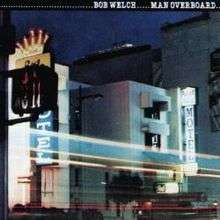Man Overboard (Bob Welch album)
Man Overboard is the fourth solo album released in 1980 by Bob Welch, former guitarist and singer with rock band Fleetwood Mac. It was reissued as a 2-for-1 CD (the first half being the songs from The Other One) by Edsel Records in 1998. Although it is not currently in print, it was made available for download on iTunes in 2008.
| Man Overboard | ||||
|---|---|---|---|---|
 | ||||
| Studio album by | ||||
| Released | September 1980 | |||
| Recorded | 1980 | |||
| Studio | Capitol Studios Los Angeles | |||
| Genre | Rock | |||
| Length | 35:33 | |||
| Label | Capitol | |||
| Producer | John Carter | |||
| Bob Welch chronology | ||||
| ||||
| Singles from Man Overboard | ||||
| ||||
| Review scores | |
|---|---|
| Source | Rating |
| Allmusic | |
Track listing
All songs written by Bob Welch except where noted.
- "Man Overboard" (Welch, John Carter) – 4:43
- "Justine" – 4:09
- "Nightmare" (Welch, Carter) – 3:24
- "B666" – 5:17
- "Don't Rush the Good Things" (Neil Gammack) – 3:40
- "The Girl Can't Stop" – 3:14
- "Jealous" – 2:32
- "Fate Decides" – 3:02
- "Reason" – 2:43
- "Those Days Are Gone" – 2:50
Personnel
Musicians
- Bob Welch – vocals, guitar
- Alan Bran – bass guitar
- David Adelstein – keyboards, synthesizer
- Alvin Taylor – drums
- Randy Meisner – vocals (tracks 8–9)
- Norton Buffalo – harmonica (track 5)
- Marty Jourard – keyboards (track 1), saxophone (track 6)
- Todd Sharp – guitar (track 3)
- Venetta Fields – vocals (tracks 6, 8)
- Paulette Brown – vocals (tracks 6, 8)
- Don Francisco – vocals (tracks 1–2, 6–10)
- Bunny Hill – vocals (track 8)
- Wendy Waldman – vocals (tracks 8–9)
Technical
- John Carter – producer
- David Cole – engineer
- Richard McKernan – assistant engineer
- Henry Marquez, Roy Kohara – artwork
gollark: For low-cost gaming computers you can, say, buy used old office computers and add a GPU.
gollark: It may be worth waiting a bit, because AMD is releasing new CPUs Soon™.
gollark: This is also not including a WiFi card, which you may want.
gollark: https://au.pcpartpicker.com/list/wmrkFt
gollark: You can get a *usable* gaming computer by taking that, upgrading the CPU, and adding a dedicated GPU, and probably tweaking some other parts.
References
This article is issued from Wikipedia. The text is licensed under Creative Commons - Attribution - Sharealike. Additional terms may apply for the media files.